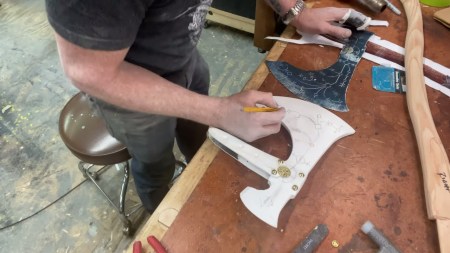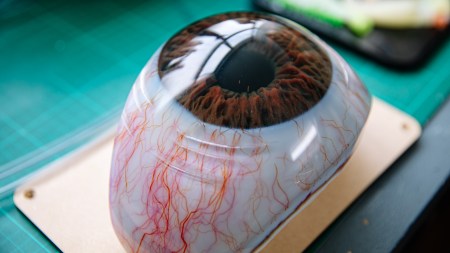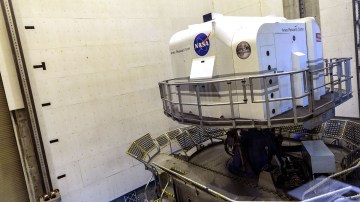Dissecting the Technology of ‘The Martian’: Air
Let's investigate the components that process air to make the ISS both habitable and comfortable for the humans inside.
This is the second in a series of articles that examine the real-life systems aboard the International Space Station (ISS) which inspired the fictional equipment found in Andy Weir’s novel (and soon-to-be-released movie) The Martian. In the first installment, we looked at the many ways in which water is conserved and recycled. This time around, we will investigate the components that process air to make the ISS both habitable and comfortable for the humans inside.
The Basics
Before getting into too much detail about the air systems on the ISS, a brief overview of the general layout is probably warranted. As with the water systems, many of the US-made air management components on the ISS have foreign counterparts. For the sake of simplicity, this article will focus only on the US equipment.
The habitable areas of the ISS are pressurized modules that are typically cylindrical in shape. Three node sections (named Unity, Harmony, and Tranquility) serve as the crossroads for all of the modules No matter which direction you choose to exit a node, your path will soon reach a dead end in some module.

On Earth we have the luxury of myriad natural processes that create air currents on a local and global scale. This helps to ensure that the same patch of air never lingers over any location for very long. In the manmade ecosystem of the ISS, however, such air flow does not occur naturally. The Intermodule Ventilation system (IMV) compensates by using fans to force airflow between the modules. Without it, the air would stagnate in those dead ends. Well, everywhere, actually.
The inter-module airflow is extremely important because the life support systems that manage the composition of the air are not present in every module. In fact, most of the US-managed life support systems are located in Tranquility. IMV mixes and moves the atmosphere to ensure that the air quality in every module is homogeneous–or nearly so.

The powerful fans that comprise the IMV are a large contributor to the cacophony that is an accepted aspect of living on the ISS. ETHOS (Environmental and Thermal Operating Systems) flight controller, Tom Horn, explained to me that specific noise levels in the fans are closely monitored and often provide clues to pinpoint trouble spots in the IMV system.
“The fans typically get louder as they need to push harder to overcome whatever clog is in the flow path. So we take regular sound level measurements every couple of weeks. Sometimes they’ll come back and we’ll say ‘Aha! You spiked by 10 decibels in this module.’ You probably have a dirty fan there.”
Horn explained the “dirt” fouling the system could be hair, skin, dirt, or even discarded trash (space litter…who knew?). It all floats around the cabin in zero-G and could get sucked into the air ducts. In fact, the ventilation filter is one of the first places that astronauts check for missing items.
Keeping Cool and Dry
With so many heat-producing people, machines, and electronics crammed into a relatively small volume, things would get warm very quickly if not for the ISS’s beefy air conditioning system. NASA calls it the Common Cabin Air Assembly (CCAA). The CCAA allows temperatures inside the ISS to hover between 70-75 degrees (F) at about 40-45% humidity. The astronauts can even configure specific temperatures for each module to fine tune their comfort level.
The CCAA is essentially a heat exchanger. Fans pull warm air from the cabin and pass it over an array of pipes. The water within those pipes is a chilly 40 degrees (F), causing the passing air to cool. The cooling process also forces water vapor in the air to condense back to a liquid state. As we know from the previous article, this water is collected and routed to the Water Processor Assembly, where it becomes potable water for the crew…again.

The largest source of humidity in the ISS’s air supply is the crew of astronauts and cosmonauts. Every bead of sweat and exhaled breath adds water vapor to the air that will eventually be reclaimed.
The largest source of humidity in the ISS’s air supply is the crew of astronauts and cosmonauts. Every bead of sweat and exhaled breath adds water vapor to the air that will eventually be reclaimed. I was surprised to learn that the second largest source of humidity is the collection of water storage bags that are stashed throughout the spaceship. Even though the bags are considered to be sealed, the barrier is not perfect. Each container leaks a trace amount of water. When all of those tiny leaks are added up, the total can’t be ignored.
Although crew comfort and water reclamation benefits are factors, the primary driver for controlling humidity within the ISS is to ensure that condensation does not occur anywhere outside of the CCAA. If the air in any module was allowed to reach dew point, water would collect on all sorts of sensitive machinery, electronics, and soft goods. This creates a risk for microbial growth as well as unintended operational conditions for the hardware. The orbital environment in space is extremely harsh on equipment as it is. There’s no sense in adding a rain forest element to make things even worse.
The Right Mixture
Air pressure within the ISS is maintained at a familiar 14.7 psi. The mixture of gases that comprises the air is also very Earth-like. Horn and his ETHOS teammates strive to keep the air’s oxygen content at 20-24%, with the remainder being nitrogen….well, most of the remainder. Obviously, other gases are present. Methane, carbon dioxide, and hydrogen are among the notable bit players. Even though their content is measured in fractions of a percent, these other gases must be closely monitored and managed.
The Atmosphere Revitalization System is a collection of three subsystems used by ETHOS flight controllers to keep a short leash on the air composition inside the ISS. It contains the Major Constituent Analyzer (MCA), Trace Contaminant Control Subassembly (TCCS) and the Carbon Dioxide Removal Assembly (CDRA).

MCA is essentially an air analysis system that pulls samples from each of the ISS modules. It uses mass spectrometry to detect nitrogen, oxygen, methane, carbon dioxide, and hydrogen while also indicating the partial pressure of each gas.
Technologically-speaking, the capability of the fictional gas analysis system in The Martian is not a far stretch.
Readers of The Martian may recall that Weir’s habitation module on Mars sported a system similar to MCA. This fictional gas analysis system can also automatically release stored gas into the air to correct for any deficiencies. Technologically-speaking, that capability is not a far stretch. The MCA actually has the ability to automatically add oxygen when it is required. It’s just that flight controllers have always chosen to manage the ISS’s oxygen content manually. I am reminded of the space shuttle commanders who routinely landed their ship with the auto pilot disabled, because “Why not?”
TCCS is used to pull unwanted stuff out of the air. To start, a fan blows air over an activated charcoal bed. This removes ammonia and high molecular weight contaminants. Next, low molecular weight gases (hydrogen, methane, carbon monoxide) are evicted in a subassembly called the High Temperature Catalytic Oxidizer (HTTCO). The HTCO oxidizes the unloved gases by heating the air through various means. The final subcomponent of the TCCS is the Lithium Hydroxide Bed. It contains granular Lithium Hydroxide which pulls acidic oxidation products from the air.
In a process that most of us are familiar with, the breathing astronauts pull oxygen from the air and replace it with carbon dioxide. On Earth, plants and trees perform the reciprocal part of the cycle during photosynthesis. There are indeed plants aboard the ISS, but not nearly enough to make a dent in the carbon dioxide content. So the role of plants in the oxygen-carbon dioxide cycle must be performed artificially.

The job of removing carbon dioxide falls on the aptly-named Carbon Dioxide Removal Assembly (CDRA). Carbon dioxide-rich air coming into the CRDA is first dried by being passed over a bed of silica gel desiccant. The air is then forced through a bed containing a porous, crystalline aluminosilicate called Zeolite. Air emerging from the Zeolite bed is pumped back into the cabin, free of carbon dioxide.
Each CRDA (there are two) contains two Zeolite beds. While one bed is filtering air, the other is exposed to the vacuum of space. This purges the trapped carbon dioxide from the Zeolite and cleans the bed for future use. The exiting carbon dioxide is sometime captured for use in another system that I will explain further down.

There is another US-managed carbon dioxide removal device on ISS. The Amine Swingbed was developed as a compact carbon dioxide scrubber for the future Orion spacecraft. A prototype unit was delivered to the ISS for testing during 2013 and 2014. The device worked adequately and it is expected to be implemented on Orion. The test unit remains on the ISS and is treated as a backup to the CDRA.
In addition to removing carbon dioxide, it is also necessary to replenish the supply of oxygen in the air. The Oxygen Generator Assembly (OGA) performs this vital task. The OGA creates oxygen through electrolysis of water. By passing an electrical current through water (the same potable water that the astronauts drink), it is split into its constituent parts; hydrogen and oxygen. The oxygen is pumped back into the cabin. The hydrogen can be vented overboard, but it is frequently used for an additional regenerative process.
Closing the Loop
The Sabatier reactor (flight controllers just call the device “Sabatier”) is another source of potable water on the ISS. It takes hydrogen output from the OGA as well as carbon dioxide collected in the CDRA to produce water and methane. The water is added to the potable water supply while the methane is vented overboard. Sabatier is a prime example of how every resource on ISS is used to its full capacity in order to minimize resupply burdens.

Venturing Further
The air regeneration systems on the ISS provide a nearly limitless source of breathable air for the humans living on board. Yet, there are still challenges to be faced before we will be ready for missions that resemble anything like Weir’s Martian expedition. The biggest obstacle will be carbon dioxide management.
The air regeneration systems on the ISS provide a nearly limitless source of breathable air for the humans living on board. For a Mars mission, the biggest obstacle will be carbon dioxide management.
Although the carbon dioxide on the ISS is only about .4% of the air content, this is roughly ten times greater than average levels on Earth. Some astronauts are not impacted by the higher concentration. Others show acute side effects (headaches, general grumpiness) that could be detrimental to their day-to-day performance. Perhaps analysis of Scott Kelly’s year in space will help us to better understand the long term effects of breathing air with elevated carbon dioxide levels.
Horn points out that there are options for reducing the carbon dioxide content on the ISS and/or future spacecraft.
“For a longer duration vehicle, like a two or three year mission to Mars, you would probably want to get CO2 down lower than what it is on ISS right now. Either that, or you want to screen your crews to make sure that they’re CO2-resistant. But that, of course, is a hardware cost that doesn’t come free. If you want to scrub CO2 lower, you’re going to have to have a beefier, heavier, more power-hungry carbon dioxide removal system. You have to strike a balance. What will allow your crew to function, and what can you actually fit on the vehicle.”
Which do you think will end up on Mars, a super-duty carbon dioxide remover, or a super-human carbon dioxide tolerator?
Author’s Note – Once again, I’d like to express my sincere thanks to Tom Horn for taking the time to explain the many air systems found on the ISS.
All images appear courtesy of NASA.
Terry spent 15 years as an engineer at the Johnson Space Center. He is now a freelance writer living in Lubbock, Texas. Visit his website at TerryDunn.org and follow Terry on Twitter: @weirdflight
5 thoughts on “Dissecting the Technology of ‘The Martian’: Air”
Leave a Reply

One Day Builds
Adam Savage’s One Day Builds: Life-Size Velocirapt…
Adam embarks on one of his most ambitious builds yet: fulfil…

Show And Tell
Adam Savage’s King George Costume!
Adam recently completed a build of the royal St. Edwards cro…
All Eyes On Perserverance – This is Only a Test 58…
We get excited for the Perserverance rover Mars landing happening later today in this week's episode. Jeremy finally watches In and Of Itself, we get hyped for The Last of Us casting, and try to deciper the new Chevy Bolt announcements. Plus, Kishore gets a Pelaton and we wrack our brains around reverse engineering the source code to GTA …

Making
Adam Savage in Real Time: God of War Leviathan Axe…
Viewers often ask to see Adam working in real-time, so this …

One Day Builds
Mandalorian Blaster Prop Replica Kit Assembly!
Adam and Norm assemble a beautifully machined replica prop k…
House of MCU – This is Only a Test 586 – 2/11/21
The gang gets together to recap their favorite bits from this past weekend's Superb Owl, including the new camera tech used for the broadcast and the best chicken wing recipes. Kishore shares tips for streamlining your streaming services, and Will guests this week to dive into the mind-bending implications of the latest WandaVision episod…

One Day Builds
Adam Savage’s One Day Builds: Royal Crown of Engla…
One of the ways Adam has been getting through lockdown has b…

Making
Adam Savage Tests the AIR Active Filtration Helmet…
Adam unboxes and performs a quick test of this novel new hel…

Making
Weta Workshop’s 3D-Printed Giant Eyeballs!
When Adam visited Weta Workshop early last year, he stopped …

One Day Builds
Adam Savage’s One Day Builds: Wire Storage Solutio…
Adam tackles a shop shelf build that he's been putting off f…


























Wow! Fantastic article, Mr. Dunn! Plenty to pique my interest before October 2!
Hope you enjoy your care package as much as I’m enjoying mine! 😉
Your articles are becoming my favorite on tested! Keep up the good work!
I got headaches running around Ruidosa as a kid bec of the altitude. Reduced oxygen? Or reduced O2 to CO2 ratio essentially?
Thanks
– That’s an interesting question. Does the air at altitude just get less dense, but with the same proportion of gasses, or does CO2 become a larger slice of the pie? I don’t know the answer.
Wonderful article.